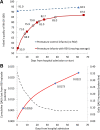Impact of Respiratory Syncytial Virus on Child, Caregiver, and Family Quality of Life in the United States: Systematic Literature Review and Analysis
- PMID: 35968873
- PMCID: PMC9377042
- DOI: 10.1093/infdis/jiac183
Impact of Respiratory Syncytial Virus on Child, Caregiver, and Family Quality of Life in the United States: Systematic Literature Review and Analysis
Abstract
Background: Respiratory syncytial virus (RSV), a leading cause of lower respiratory tract infection in US children, reduces quality of life (QOL) of children, their caregivers, and families.
Methods: We conducted a systematic literature review in PubMed, EconLit, and other databases in the United States of articles published since 2000, derived utility lost per RSV episode from cohort studies, and performed a systematic analysis.
Results: From 2262 unique citations, 35 received full-text review and 7 met the inclusion criteria (2 cohort studies, 4 modeling studies, and 1 synthesis). Pooled data from the 2 cohort studies (both containing only hospitalized premature infants) gave quality-adjusted life-year (QALY) losses per episode of 0.0173 at day 38. From the cohort study that also assessed caregivers' QOL, we calculated net QALYs lost directly attributable to RSV per nonfatal episode from onset to 60 days after onset for the child, caregiver, child-and-caregiver dyad of 0.0169 (167% over prematurity alone), 0.0031, and 0.0200, respectively.
Conclusion: Published data on QOL of children in the United States with RSV are scarce and consider only premature hospitalized infants, whereas most RSV episodes occur in children who were born at term and were otherwise healthy. QOL studies are needed beyond hospitalized premature infants.
Keywords: United States; caregiver; infant; premature; quality of life; quality-adjusted life-year (QALYs); respiratory syncytial virus (RSV); systematic review; utility.
© The Author(s) 2022. Published by Oxford University Press on behalf of Infectious Diseases Society of America.
Conflict of interest statement
Potential conflicts of interest. E. L. G., D. H., D. M. B., R. M. G., K. R. R., and D. S. S. were supported under an agreement between Sanofi and Brandeis University, but none received any direct funding nor in-kind support from the sponsors. C. B. N. is an employee of Sanofi and may hold shares and/or stock options in the company. L. B. declared no conflicts. All authors have submitted the ICMJE Form for Disclosure of Potential Conflicts of Interest. Conflicts that the editors consider relevant to the content of the manuscript have been disclosed.
Figures



References
-
- Kimberlin DW, Brady MT, Jackson MA and Long SS, eds. Respiratory syncytial virus. Red book: 2018 report of the committee on infectious diseases. Itasca, IL: American Academy of Pediatrics, 2018: 682–92.
-
- Hall CB, Weinberg GA, Blumkin AK, et al. Respiratory syncytial virus-associated hospitalizations among children less than 24 months of age. Pediatrics 2013; 132:e341–48. - PubMed
-
- Rha B, Curns AT, Lively JY, et al. Respiratory syncytial virus-associated hospitalizations among young children: 2015–2016. Pediatrics 2020; 146:e20193611. - PubMed
Publication types
MeSH terms
LinkOut - more resources
Full Text Sources
Medical
Miscellaneous

